While negotiation is the cornerstone of securing B2B deals, many salespeople struggle to adapt beyond basic strategies, leaving them vulnerable when faced with unexpected scenarios. To empower you to break through these limitations and negotiate with confidence, we’ll explore some proven B2B negotiation tactics.
Understanding the Basics of Negotiation
Let’s first establish the fundamentals before diving into the strategies.
What is Negotiation, Anyway?
Negotiation is a process where two or more parties come together to discuss and reach an agreement on a particular issue. In B2B sales, Negotiation typically occurs after initial discussions and presentations, as both parties seek to finalize the terms of a deal.
This process often involves addressing concerns, clarifying expectations, and finding common ground to ensure a successful outcome for all parties involved. Effective negotiation in B2B sales requires strong communication skills, an understanding of market dynamics, and the ability to build and maintain relationships.
The Essentials Before You Step on the Negotiation Floor

Now, before we begin negotiating, there are some key elements that we need to consider in order to have a successful outcome.
Goals and Objectives: It is important for us to clearly define our goals and objectives. What do you want to achieve with this deal? Is it a specific price point, a longer contract term, or access to specific resources? This means having a clear idea of your desired outcomes.
Knowing Your (and Their) Interests: Secondly, we must also take into account the interests of both parties involved in the negotiation. What are your priorities and needs in this deal? What are theirs? You must understand each other’s needs and concerns in order to find common ground and reach a mutually beneficial agreement.
BATNA: This stands for “Best Alternative To a Negotiated Agreement.” Basically, it’s your backup plan if the negotiation doesn’t go your way. Knowing your BATNA gives you confidence and prevents you from making concessions that significantly hurt your interests.
Joint Value Creation: Lastly, joint value creation plays a vital role in successful negotiations. This involves identifying ways for both parties to benefit from the agreement rather than just one side gaining at the expense of the other. By creating value together, we can build stronger relationships and increase the chances of reaching an effective resolution.
Negotiating with Confidence: Strategies for Success
To become a successful negotiator, one must possess strong communication skills and be well-prepared before entering into any negotiation discussion. These two crucial aspects play a significant role in building confidence during negotiations.
Pre-Negotiation Preparation: Know Before You Go
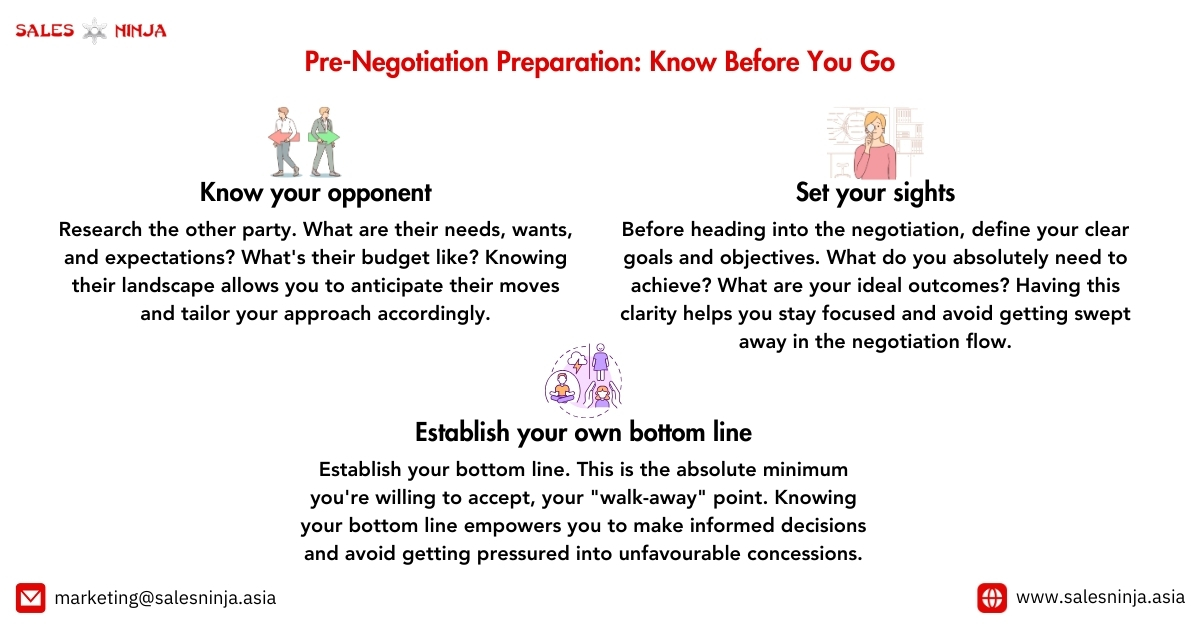
In any negotiation process, the more prepared you are for the discussion, the better position you will be in to achieve your desired outcome confidently. Here are some steps you should take during the pre-negotiation phase:
- Know your opponent: Research the other party. What are their needs, wants, and expectations? What’s their budget like? Knowing their landscape allows you to anticipate their moves and tailor your approach accordingly.
- Set your sights: Before heading into the negotiation, define your clear goals and objectives. What do you absolutely need to achieve? What are your ideal outcomes? Having this clarity helps you stay focused and avoid getting swept away in the negotiation flow.
- Establish your own bottom line: Establish your bottom line. This is the absolute minimum you’re willing to accept, your “walk-away” point. Knowing your bottom line empowers you to make informed decisions and avoid getting pressured into unfavorable concessions.
Communication Skills During Negotiations:
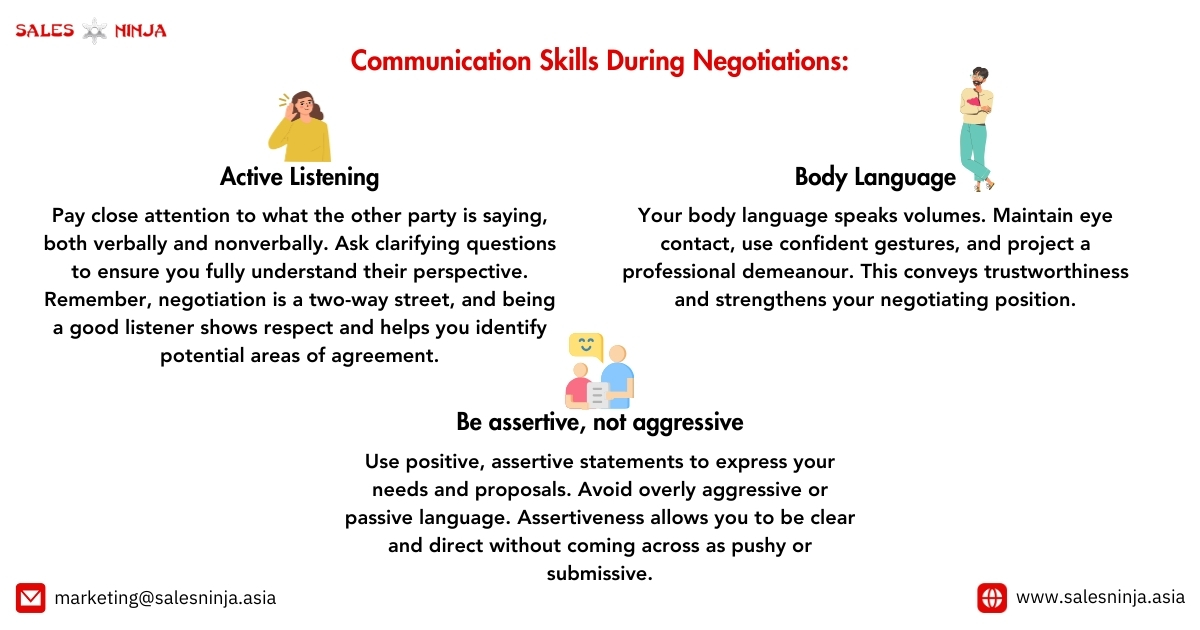
Once you have completed thorough preparation for negotiations, it’s time to put those plans into action through effective communication techniques. Here are some tips for developing stronger communication skills during negotiations:
- Active Listening: Pay close attention to what the other party is saying, both verbally and nonverbally. Ask clarifying questions to ensure you fully understand their perspective. Remember, negotiation is a two-way street, and being a good listener shows respect and helps you identify potential areas of agreement.
- Body Language: Your body language speaks volumes. Maintain eye contact, use confident gestures, and project a professional demeanour. This conveys trustworthiness and strengthens your negotiating position.
- Be assertive, not aggressive: Use positive, assertive statements to express your needs and proposals. Avoid overly aggressive or passive language. Assertiveness allows you to be clear and direct without coming across as pushy or submissive.
Strategies to Overcome Challenges Arising from Situational Contexts
Negotiation challenges that may arise in B2B sales situations can range from difficult clients to competing offers and tight deadlines. Understanding the nuances of these challenges, their underlying drivers, and implementing targeted strategies to overcome them is essential for achieving success in negotiations. Let’s look at some of these situation problems and ways to overcome them.
Dealing with Uncompromising Customers in B2B Negotiations
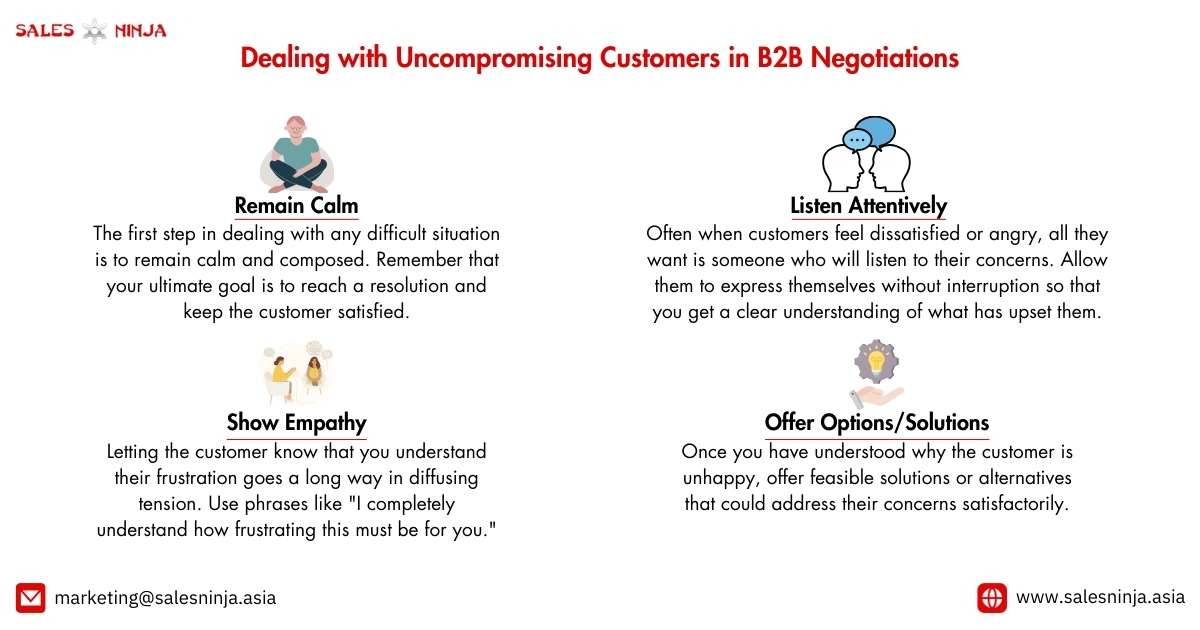
Navigating B2B negotiations may be difficult, and dealing with a seemingly hesitant customer adds another layer of complexity. These consumers’ aggression, dismissiveness, or lack of attention can easily throw you off guard. While the reasons for their actions may differ, the salesperson’s defensiveness or avoidance rarely results in a beneficial consequence. Here’s how to bargain convincingly in such situations:
Understanding the Challenge: Think about possible causes for their actions. Do they feel their demands aren’t being satisfied, have they had bad experiences in the past, or are they just sticking to a rigid negotiation strategy Next, how it might affect negotiations – can their behavior stall progress, create a negative atmosphere, or make finding a win-win solution difficult?
Strategies:
- Remain Calm: The first step in dealing with any difficult situation is to remain calm and composed. Remember that your ultimate goal is to reach a resolution and keep the customer satisfied.
- Listen attentively: Often when customers feel dissatisfied or angry, all they want is someone who will listen to their concerns. Allow them to express themselves without interruption so that you get a clear understanding of what has upset them.
- Show Empathy: Letting the customer know that you understand their frustration goes a long way in diffusing tension. Use phrases like “I completely understand how frustrating this must be for you.”
- Offer options/solutions: Once you have understood why the customer is unhappy, offer feasible solutions or alternatives that could address their concerns satisfactorily. Even if there isn’t an immediate solution available at hand, assure the customer that you will look into their issue personally and provide regular updates until it gets resolved.
Negotiating Under Tight Deadlines
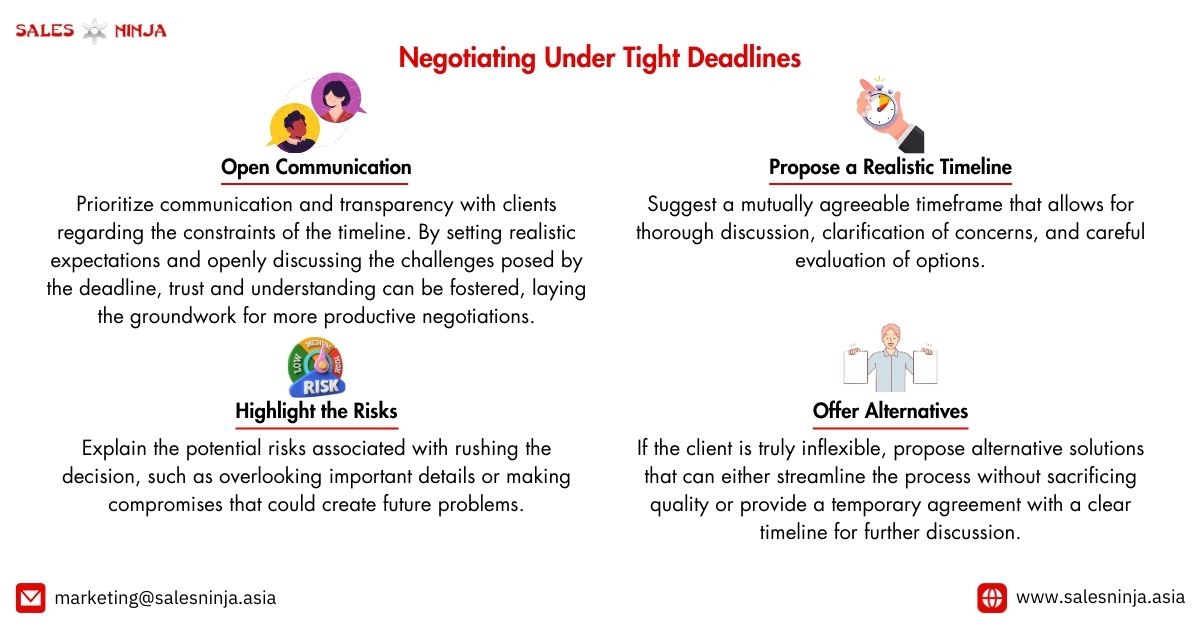
Navigating negotiations with tight deadlines is another common challenge in B2B sales. Clients may impose pressure to finalize deals swiftly, leaving little room for thorough discussion and consideration of options. In such situations, sales professionals often feel compelled to rush the process, sacrificing critical aspects of negotiation in the pursuit of meeting deadlines.
Unfortunately, this approach can lead to suboptimal outcomes, as decisions made under duress may not fully align with the interests and objectives of both parties. Salespeople may overlook important details or fail to adequately address client concerns, risking dissatisfaction or even deal failure.
To negotiate confidently in the face of tight deadlines, you need to resist the urge to succumb to pressure and instead, adopt strategic and proactive approaches.
Strategies:
- Open communication: Prioritize communication and transparency with clients regarding the constraints of the timeline. By setting realistic expectations and openly discussing the challenges posed by the deadline, trust and understanding can be fostered, laying the groundwork for more productive negotiations.
- Propose a Realistic Timeline: Suggest a mutually agreeable timeframe that allows for thorough discussion, clarification of concerns, and careful evaluation of options.
- Highlight the Risks: Explain the potential risks associated with rushing the decision, such as overlooking important details or making compromises that could create future problems.
- Offer Alternatives: If the client is truly inflexible, propose alternative solutions that can either streamline the process without sacrificing quality or provide a temporary agreement with a clear timeline for further discussion.
If the client insists on an unrealistic deadline and is unwilling to budge on important points, be prepared to walk away from the negotiation. This protects your long-term interests and sends a message that you value quality agreements over rushed deals.
Negotiating When Facing Price-Driven Competitors
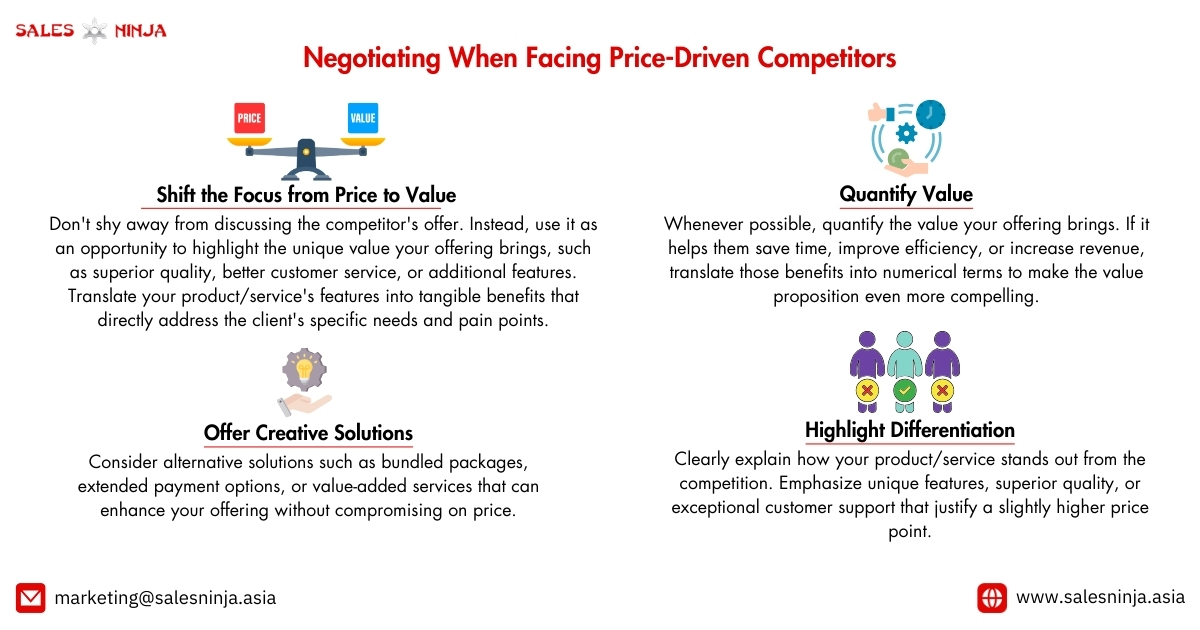
Negotiations are never easy due to the continual danger of competitors offering comparable goods and services at lower costs. This may put the buyer in a position where they are just concerned with price, sometimes ignoring the value that your solution offers. While facing this challenge, falling into the trap of ineffective responses can further complicate negotiations.
However, to “win” the deal, you might be tempted to match or undercut the competitor’s price, which can damage your profitability and set a harmful precedent for future negotiations. Besides, discounting Heavily can create the perception that your product/service is inherently less valuable compared to the competition. So what you can do?
Strategies:
- Shift the Focus from Price to Value: Don’t shy away from discussing the competitor’s offer. Instead, use it as an opportunity to highlight the unique value your offering brings, such as superior quality, better customer service, or additional features. Translate your product/service’s features into tangible benefits that directly address the client’s specific needs and pain points.
- Quantify Value: Whenever possible, quantify the value your offering brings. If it helps them save time, improve efficiency, or increase revenue, translate those benefits into numerical terms to make the value proposition even more compelling.
- Offer Creative Solutions: Consider alternative solutions such as bundled packages, extended payment options, or value-added services that can enhance your offering without compromising on price.
- Highlight Differentiation: Clearly explain how your product/service stands out from the competition. Emphasize unique features, superior quality, or exceptional customer support that justify a slightly higher price point.
Budget Constraints
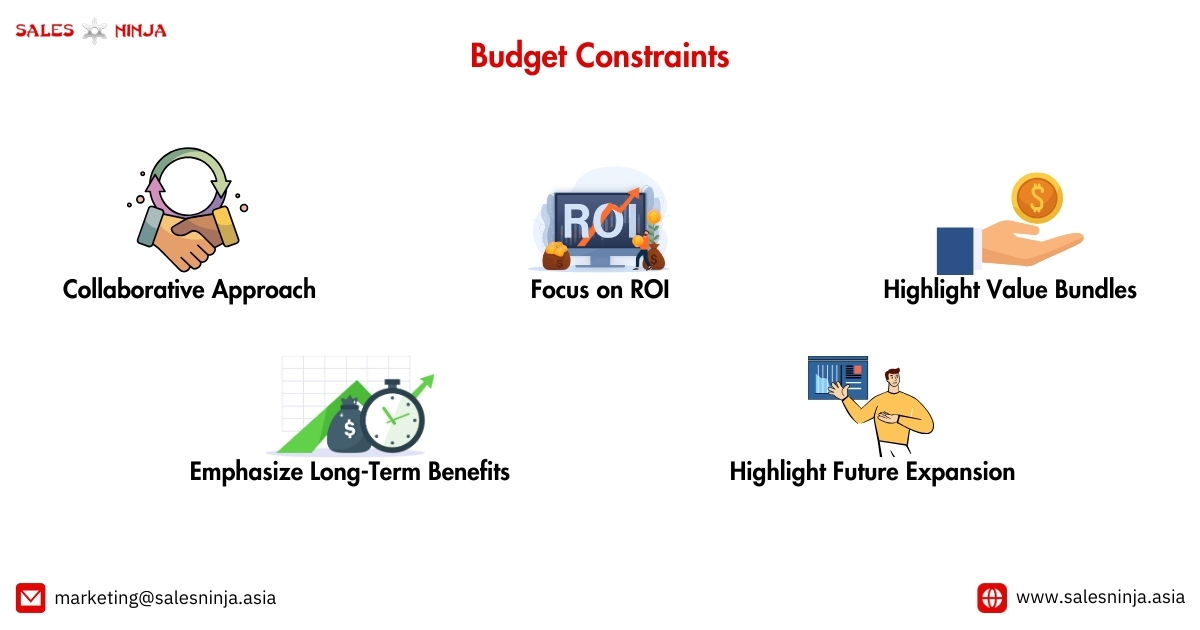
A common hurdle in negotiations is encountering customers with limited budgets. While understanding their financial limitations is crucial, it can be challenging to secure a deal without compromising your value proposition. Here’s how to handle these situations effectively, avoiding common pitfalls:
Strategies:
- Collaborative Approach: Engage in a collaborative conversation to understand the customer’s budget limitations and specific needs. Ask open-ended questions to identify areas where your offering can provide the most value within their budget.
- Focus on ROI: Shift the conversation from features to Return on Investment (ROI). Demonstrate how your product/service can save them money in the long run, increase efficiency, or generate additional revenue.
- Highlight Value Bundles: Consider creating value bundles that combine essential features at a competitive price point. This allows them to access the core functionalities they need without exceeding their budget.
- Emphasize Long-Term Benefits: Go beyond the immediate cost and showcase the long-term benefits of investing in your offering. Talk about reduced maintenance costs, increased productivity, or improved customer satisfaction.
- Highlight Future Expansion: If their budget cannot accommodate the full scope of your offering, explore the possibility of phased implementation or future expansion. This demonstrates your commitment to their long-term success.
Complex Decision-Making Processes
You might encounter situations with complex decision-making processes. Because, in B2B sales, it is not uncommon for decision-making processes to involve multiple stakeholders with varying priorities and opinions. This can make the negotiation process more complex and time-consuming. Complex decision-making processes often occur in larger organizations where there are many departments involved in the buying process. Each department may have its own set of criteria that need to be met before a purchase can be approved. Nonetheless, there are a few calculated methods you might use to deal with this circumstance.
Strategies:
- Tailor Your Communication: Identify all key stakeholders involved in the decision process, including their roles, responsibilities, and potential influence. Utilize tools like LinkedIn or internal company information to gather this information. Then craft your message to resonate with each stakeholder’s specific interests and concerns. Address their unique pain points and demonstrate how your offering addresses their individual priorities.
- Focus on Value Proposition: Clearly articulate the value proposition your offering delivers to the entire organization, not just individual needs. Highlight how it aligns with the overall goals and objectives of the company.
- Manage Expectations: Be transparent about the length of the decision-making process and manage expectations regarding timelines clearly.
Common Mistakes to Avoid
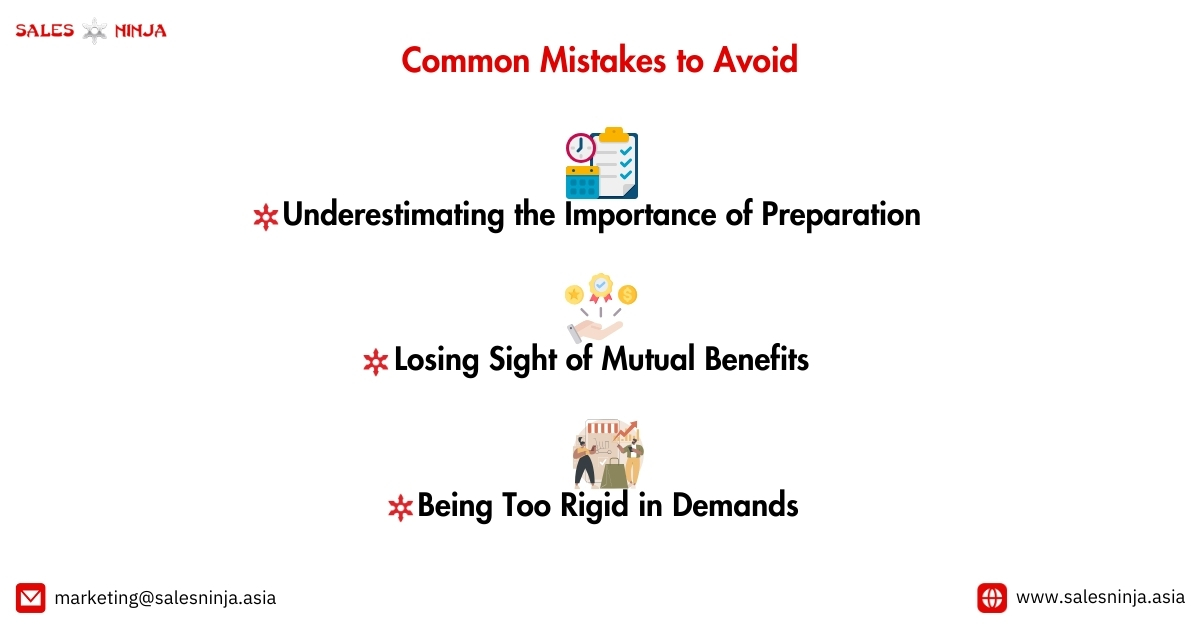
During a negotiation, it is important to have a clear understanding of the common mistakes that can hinder success. These include-
Underestimating the Importance of Preparation:
One mistake that many people make during negotiations is not spending enough time preparing beforehand. Without proper preparation, you may enter into a negotiation without a solid plan or strategy in place which can lead to making impulsive decisions or accepting unfavorable terms.
Losing Sight of Mutual Benefits:
Negotiations should be approached with the mindset of creating mutually beneficial outcomes for both parties involved. It is easy to get caught up in trying to secure individual gains but this can often result in an unsuccessful outcome as neither side will want to compromise. Focusing solely on one’s own interests may also damage relationships with the other party and jeopardize future collaborations.
Being Too Rigid in Demands:
Being inflexible during negotiations can cause roadblocks and prevent progress from being made towards reaching an agreement. Insisting on getting only what you want without considering any compromises or alternatives offered by the other party may result in a stalemate situation where no deal is reached at all.
It’s crucial to keep an open mind when negotiating and consider various options presented by both sides rather than sticking strictly to initial demands. Being flexible allows room for finding creative solutions that meet everyone’s needs while maintaining positive rapport between the parties involved.
Take the step towards confident negotiation
Take action today and start implementing these strategies in your sales journey. With the right mindset and tools at hand, you have the power to become an expert negotiator who confidently navigates any challenge or opportunity that comes your way. So let’s begin this journey together towards achieving success through confident negotiations!
To further support your journey towards confident negotiation, find free resources on our website or subscribe to our newsletter for regular tips on improving your negotiating skills. You can also contact us for personalized consultation services tailored to your specific needs.


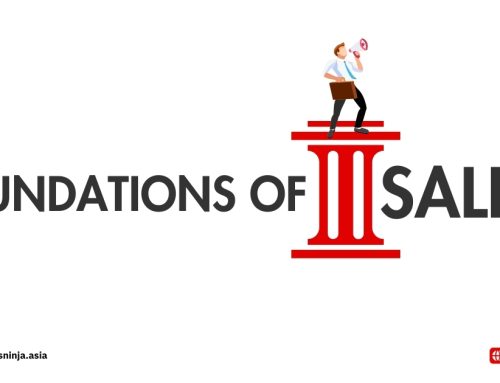



Leave A Comment